Here’s my attempt to answer the 10 most-often-asked questions I got from you over the years about telescope mounts.
1. What is a telescope mount?
A telescope mount basically does two things. First, it holds your telescope securely, and second, it allows you to move the telescope so that it can be pointed precisely at the objects in the night sky you want to observe or photograph. Most mounts have two elements: a sturdy tripod with legs made of metal or wood, and a second element that’s known as the ‘mount head’. The mount head is typically made of metal and usually has two axes to slew your telescope to any object in the sky.
2. What are the different types of telescope mounts?
There are two main types of telescope mounts, altitude azimuth mounts, or alt-az mounts, and equatorial mounts, or EQ mounts in short. Both Alt-Az and EQ mounts can track the motion of celestial objects in the sky, but they do so in different ways. Alt-az mounts track objects using simple up/down, and left/right movements, whereas Equatorial mounts are tilted at an angle that matches the latitude of your location. This angle also corresponds with what is called the north celestial pole, which almost matches the altitude at which the north star Polaris appears in your sky. If you’re living in the southern hemisphere, your angle or tilt will correspond with the south celestial pole, close to the star called Octantis. Once aligned with the celestial pole, your equatorial mount can exactly track the movement of objects in the sky. You will probably come across lots of different names for telescope mounts such as fork mounts, Dobsonian mounts, or german equatorial mounts. Just remember that most of these mounts can be placed in the two main categories of either alt-az or eq mounts.
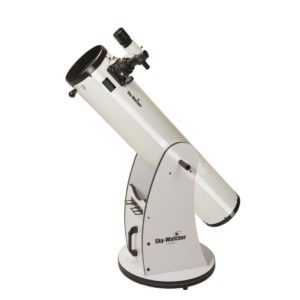

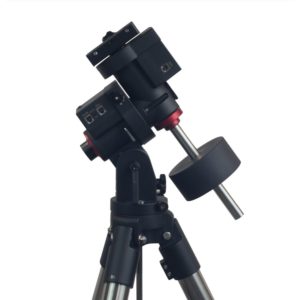

3. What is the best telescope mount?
This really depends on your personal goals. The first question you need to answer is whether your main goal is to observe the night sky with a telescope, or whether you also want to get into some planetary imaging or astrophotography. Let’s say your main goal is to observe the sky with a telescope and look at some planets, stars, nebulas, or galaxies. If that’s your goal, you can get by with a simple, manual mount like a Dobsonian mount and a telescope. Keep in mind that with a manual mount, you’ll need to do the finding and tracking of objects in the night sky yourself, which can be challenging depending on the weather conditions and your skill in finding objects in the sky.
If your goal is to do some planetary imaging, I would recommend getting an alt-az or eq mount with a computerized goto system. With such a system, you’ll be able to find and track the planets automatically in the night sky. Most of such telescopes have a hand controller with which you can select any object in the night sky. Your mount will then automatically move to that object and start tracking that object. This saves you a lot of trouble of manually having to adjust the position of your telescope mount to keep the object in the center of your field of view.
Finally, if your goal is to get into astrophotography, I highly recommend an eq mount with a computerized go-to system. Only EQ mounts can exactly track the movement of the objects in the sky as they can be aligned with the north or south celestial pole. Now, some alt-az mounts come with a so-called wedge which can be used to turn your alt-az mount into an eq mount. However, as far as I know, this solution never results in tracking that is as accurate as buying a full-fledged computerized eq mount. For an in-depth comparison of beginner-level computerized equatorial mounts, click here.

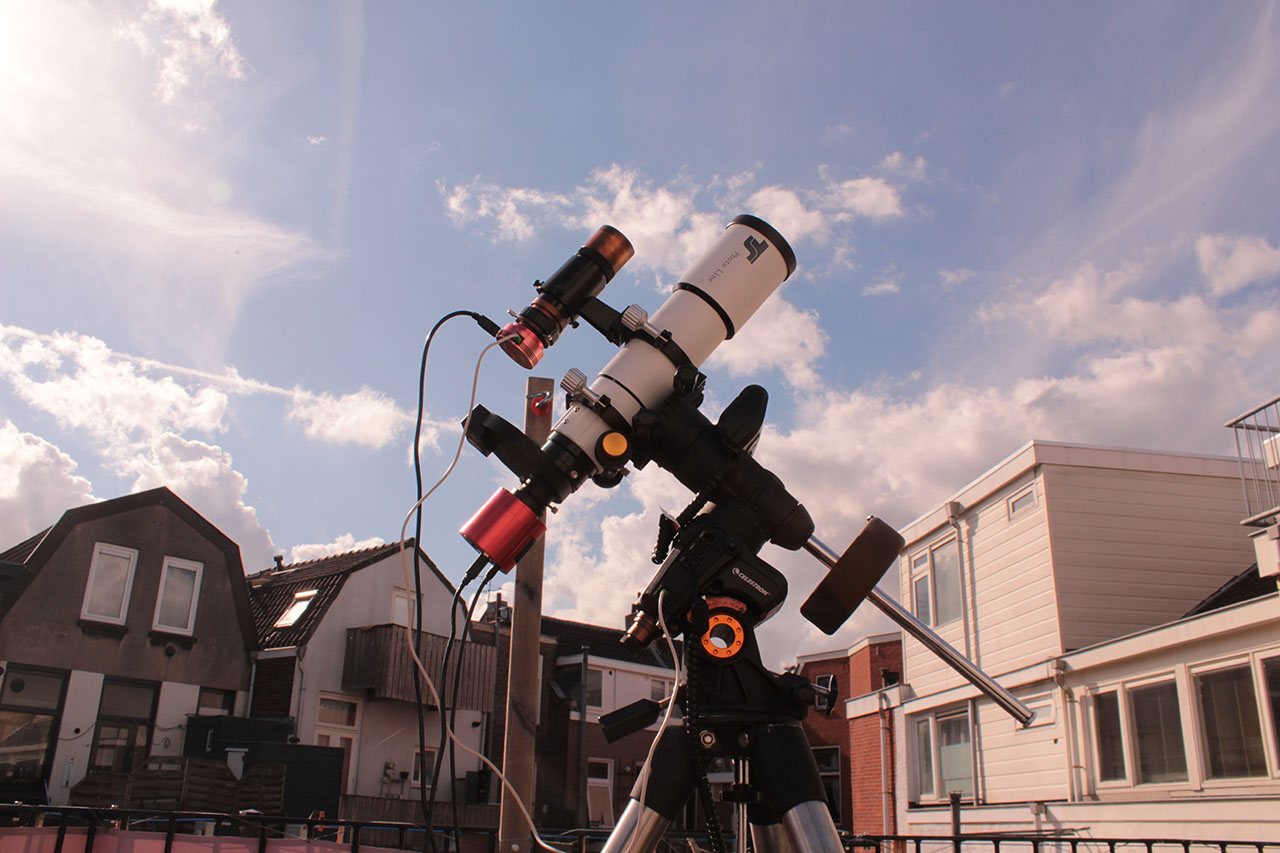

4. What is the best telescope mount for planetary imaging?
If you’re going to image the planets, you’ll need a telescope with a long focal length and relatively large aperture since planets are among the tiniest objects in the sky. Most probably, you’ll end up with a typical Maksutov or Schmidt-Cassegrain type of telescope. Most of these types of telescopes are sold with computerized alt-az mounts, such as a single-arm style mount for lighter telescopes or fork mounts for heavier telescopes. These mounts are good for observing and tracking the planets, but they are not great for astrophotography. So if you’re interested in planetary imaging, you should also ask yourself whether, at one point, you also want to get into deep-sky astrophotography. If the answer is yes, then I would strongly recommend you already invest in an eq mount. This being said, there are a couple of advantages when using an alt-az mount versus using an eq mount. First of all, alt-az mounts are not tilted, so they usually don’t need any counterweights. This makes alt-az mounts a bit lighter and more portable as compared to eq mounts. Also, alt-az mounts don’t need to be aligned with the celestial pole, and they can continuously track objects across the sky without having to perform a so-called meridian flip, which is typical for eq mounts. And as I said before, some alt-az mounts can be outfitted with an additional wedge to mimic the tracking capacity of an eq mount.
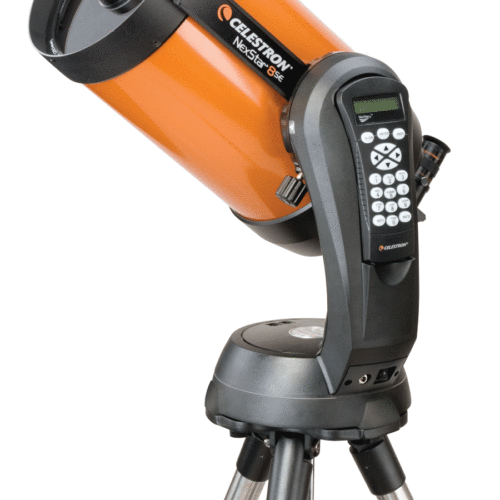

5. What is the best telescope mount for astrophotography?
I get this question a lot and the answer is tricky because this depends on things like the type of telescope you’re going to use, your budget, and whether you want a mobile setup that you can take with you on a weekend or holiday trip. However, I do have a couple of general recommendations. First, you always want to buy an equatorial mount with a computerized goto system. As mentioned before, eq mounts can be polar aligned and accurately ‘track’ your favorite Deep Sky Objects (DSO’s) from any location. Also, a computerized goto system is pretty useful, as you will be able to automatically find and track objects in the sky. Another thing you should take into account is whether your mount can make a so-called ASCOM connection. ASCOM is a non-commercially developed software standard with which you can connect astrophotography gear like your telescope mount to software that uses the ASCOM standard. This will enable you to control your mount remotely, using your PC or Laptop. My next tip is to buy a telescope mount with an auto-guiding option. This option can dramatically increase the accuracy with which you can track objects in the night sky using a second guide scope and camera. I will get back to auto-guiding in a minute. Last but certainly not least, you should also check out the payload capacity of your mount. Payload capacity refers to the weight of all your astrogear, like your telescope and camera, you will put on the mount. There is an unwritten astrophotography rule that you should take about 50% of the maximum payload capacity as the upper weight limit for astrophotography. Of course, this may vary between mounts but as a rule, your tracking will become less accurate when you get closer to the maximum payload capacity of your telescope mount. For an in-depth overview of good astrophotography mounts for astrophotography, click here.
6. What is the best telescope and mount combination for astrophotography?
I get this question a lot and it’s actually a great question. As already explained, you first have to make sure that your mount has a sufficient payload capacity to carry the weight of your telescope, camera, and additional gear you may want to use. Another important aspect is whether the tracking accuracy of the mount is sufficient to take multi-minute exposures of the night sky. Astrophotography is all about taking long exposure photos of the faint light from objects in space like nebulas and galaxies. So if you’re going to take multi-minute photos, your tracking needs to be as accurate as possible to avoid stuff like elongated stars or even star trails on your pictures. Now, tracking accuracy depends on lots of stuff, like whether you correctly have set up and balanced your telescope and camera on your mount; whether you use auto-guiding; and weather conditions. One additional aspect is often left out of the conversation, and that is the so-called imaging scale you use to photograph the night sky.

Based on the focal length of your telescope and the pixel size of your camera, you can calculate the so-called imaging scale in arcseconds per pixel using the following formula: (Pixel Size divided by the focal length of your telescope) x 206.265. The higher number your imaging scale is, the less accurate your tracking needs to be. For example, if I would photograph the night sky with my Canon 1200D camera which has a pixel size of 4.3, and using a 200mm focal length lens, my imaging scale would be 4.4. When I’m using my Celestron Edge HD 8” telescope at its native focal length of about 2000mm with my asi1600 camera that has a pixel size of 3.8, my imaging scale would be 0.39. This means that my imaging scale, or resolution, is actually 11 times more sensitive when using my Edge HD telescope and camera than when imaging with my Canon 1200D at 200mm focal length. So in the case of my DSLR camera, I can probably get away with a cheaper, less accurate tracking mount, or even a sky tracker, whereas with my Celestron Edge HD I need a high-quality EQ mount that can track with a sub-arcsecond per-pixel accuracy.
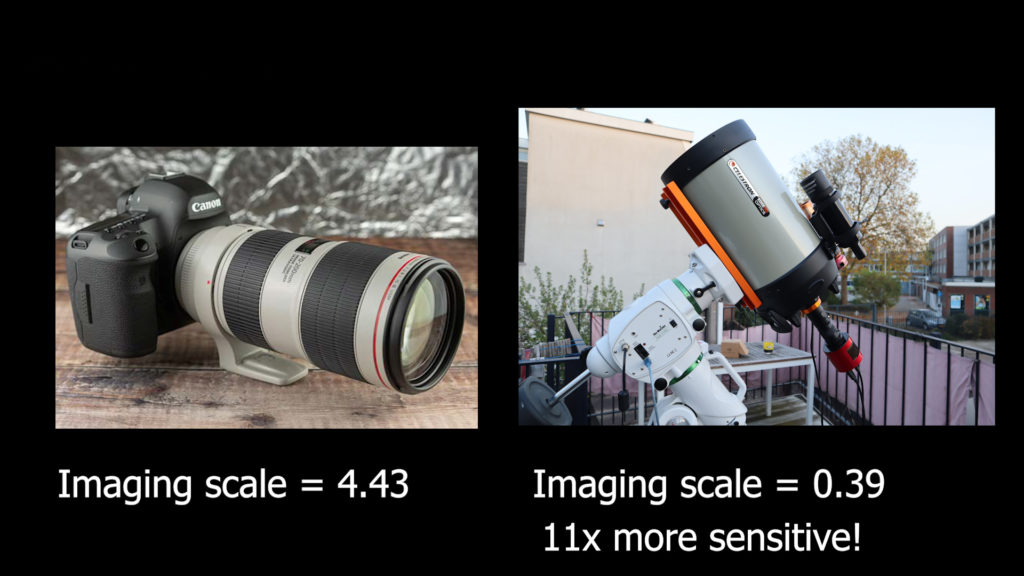
7. How do I set up an equatorial mount?
The first thing you must do is to point the tripod of your telescope mount into the north (360 degrees) direction if you’re in the northern hemisphere. If you don’t know where the north is, you can use a compass or a smartphone app. Next, it is good practice to level your mount. Lots of mounts have a bubble leveler as part of the tripod, but I’m always using a leveler like this one. Next, you’ll need to put the mounts’ head in the correct latitude position of your location. If you’re unaware of what the latitude of your location is, you can always use google maps and right-click on any location and it will show you the latitude and longitude of that location. For example, I’m at 52 degrees latitude. Once you know your latitude, you can use the altitude-azimuth bolts on your eq mounts to put it in the correct position. After that’s done, you first want to put the counterweights on your mount before mounting the telescope. This is actually something I forgot to do in some of my videos, and I always got a lot of comments from you guys, and rightfully so! After you’ve mounted your telescope, camera, and perhaps other astrogear, it is a simple matter of balancing the telescope with the counterweights. Some astrophotographers say that a slightly unbalanced mount may perform better as there is always some tension on the gears when your mount is tracking objects, but I hardly noticed any differences in my everyday astrophotography sessions over the past years. For a more in-depth tutorial on how to set up and polar align an equatorial mount, click here.
8. How can nail my polar alignment with my equatorial mount?
The alignment of your mount with the celestial pole is incredibly important. The better your polar alignment is, the better your mount is able to track objects in the sky. Most EQ mounts come with polar scopes like this one, that show the position of Polaris, the north star, in relation to the constellations like the big dipper and Cassiopeia. With most telescope mounts, you’ll need to move the RA axis to about 90 degrees so that you can actually look through your polar scope at the sky. You should be able to see Polaris, the north star, through your polar scope if your telescope is facing north and when it’s in the correct latitude position. It is then a matter of adjusting the alt-az bolts and the right ascension and declination bolts on your eq mount until the star Polaris is close to the center of your polar scope. Polaris should not be exactly in the center, as Polaris is close, but not exactly in the same location as the north celestial pole. If you want to know where Polaris should be positioned in your polar scope, you can check out polar finder apps that show you how to put Polaris slightly off-center, so you’re exactly aligned with the north celestial pole. Most mounts also offer additional computerized options to correctly align your mount. For example, my Celestron AVX has an all-star alignment option with which you’ll be able to slew your telescope to 2 to 6 stars in the sky. You can center these stars in the field of view of your telescope, and the mount will use that information to determine its position. An even more advanced option is to use software to really nail your polar alignment. For example, I’m always doing my polar alignment procedure using a software tool named Sharpcap. After connecting my camera to Sharpcap, the program will show me exactly how to move my mount left, right, up, or down until I’m exactly polar aligned. Another option is to use an additional Ipolar camera with software that uses a similar method. For a more in-depth tutorial, click here.
9. How can I improve the tracking accuracy of my mount?
You can improve the tracking accuracy of your computerized equatorial mount considerably with autoguiding. Autoguiding involves making small corrections to the position of your equatorial mount when taking long-exposure pictures of the night sky. Most astrophotographers, including myself, use a separate guide scope and a guide camera that can be attached to your main telescope. You can connect your guide camera to your mount directly by using an ST4 cable that can be inserted in the auto guider port of the mount. Alternatively, you can connect your guide camera using a USB cable to your PC or laptop, and use an ASCOM connection. Most astrophotographers use PHD2 guiding software where your guide camera will take approximately 1-second pictures of the night sky and tracks the position of a so-called guidestar that is near the target you are imaging. If PHD2 notices minor movements in the guidestar, it will tell the mount automatically to make small corrections so that the guidestar remains in the same position when taking long-exposure pictures. For more information on guide scopes and guide cameras, click here. And you can check out my tutorial on how to set up your guidescope and guide camera in PHD2 guiding software here.
10. How can I control my mount remotely?
First and foremost, you’ll need to check whether your mount has an ASCOM option. As mentioned before, ASCOM is a non-commercially developed software standard that allows you to control your mount remotely using software that has the ASCOM standard. There are many software programs available with which you can control your mount remotely. I personally started using Stellarium and Cartes du Ciel which show a visual, real-time chart of the night sky. This makes it easy to find objects in the sky and to point your mount to that object. One downside when using these software tools is that the target will often not be exactly centered in your telescopes’ field of view. So often, you still need to make small adjustments to get the object you want to photograph exactly in the center of your photo. The absolute best way to remote control your mount is with software that includes a plate-solving option. I personally use Sequence Generator Pro. Platesolving is a method where a live picture you take of the night sky is compared to a database of star positions. The software will find a match between your live picture and the database, after which it will tell your mount to make small corrections to get the object you want to image exactly in the center of your field of view. Besides sequence generator pro, there are other software tools like NINA and Astrophotography tool that have a plate-solving option as well. Here’s a link to my illustrative guide on how to set up and use sequence generator pro.
Last but not least
I’m happy to hear from you guys if my answers to these ten most asked questions about telescope mounts were useful in the comment section below. Also, if you have alternative questions about telescope mounts or backyard astrophotography in general, don’t hesitate to ask them. I always read your comments and I’ll do my best to tailor my blogs and videos about astrophotography and astronomy to your needs.
Clear skies!
Wido.
One Reply to “Telescope mounts: Top 10 questions answered!”